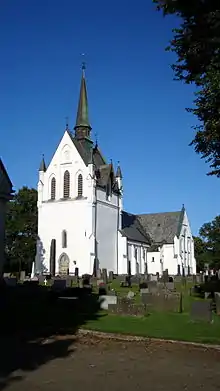Eidsberg Church
Eidsberg Church (Norwegian: Eidsberg kirke or Østfold-domen) is a parish church located at Eidsberg in Viken county, Norway. The Church is located down to the river Glomma by the side of the County Road 124. Eidsberg Church is associated with the Østre Borgesyssel deanery of the Diocese of Borg.[1][2]
| Eidsberg Church Eidsberg kirke | |
|---|---|
Østfold-domen | |
 | |
| Religion | |
| Affiliation | Protestant |
| Province | Viken |
| Ecclesiastical or organizational status | Deanery |
| Year consecrated | 1250–60 |
| Location | |
| Location | Eidsberg, Norway |
| Architecture | |
| Architect(s) | Paul Due (1881) |
| Style | Neo Gothic |
| Groundbreaking | 13th century |
| Materials | Stone |
| Website | |
| Official | |
Overview
Eidsberg church is consecrated to St. Olav who is depicted on a stone sculpture over the entrance to the church. It is the only one of the village's medieval churches to have been preserved. The church was constructed of stone and was probably built in the latter half of the 12th century in Romanesque style. The church was damaged in a fire around 1420. During the period 1880 - 1881, an extensive reconstruction of the church was carried out. Architect Paul Due provided the design resulting in the church having a Neo-Gothic cruciform style. There was an additional restoration during the 1920s and between 1959–1960. [3] [4]
Tenor kirkeruin
The ruins of Tenor chapel (Tenor kirkeruin i Eidsberg) are located north of Eidsberg church. This medieval chapel was built of brick and macadam in the late 1200s as an annex to Eidsberg church. The chapel was closed in 1536 and stood deserted from about 1560. The chapel is mentioned in 1619 by Bishop Niels Simonsen Glostrup who says that the chapel is closed. As late as the early 1700s, most of the walls were still standing. The ruins were excavated between 1952 and 1956 by Bernt C. Lange and Håkon Christie. A new chapel was constructed during 1932.[5][6]
Church Interior
Only the baptismal font dating from the 1200s retains the original medieval decor. It is of soapstone and shaped like a cup. The altarpiece was donated to the church in 1651, and was performed by craftsman Christopher Ridder (d.1695), who also designed the pulpit. The pulpit is made of oak with figures of Christ and the Evangelists in portal fields. The altarpiece is a baroque style rendering of the Crucifixion of Jesus.[7] [8]
Ski jumping world record
On 22 November 1808 officer Norwegian-Daniah Olaf Rye, made the first recorded ski jump in history at The Eidsberg Church site with first ski jumping world record at 9.5 metres (31 ft).[9]
| Date | Ski jumper | Country | Metres | Feet |
|---|---|---|---|---|
| 22 Movember 1808 | Olaf Rye | 9.5 | 31 |
Gallery
.jpg.webp) Church west portal
Church west portal.jpg.webp) Statue of St. Olav
Statue of St. Olav Church baptismal font
Church baptismal font Church Tower
Church Tower.jpg.webp) Old Church Bell
Old Church Bell Church Pulpit
Church Pulpit Church Altar
Church Altar Eidsberg Church interior
Eidsberg Church interior Site of chapel ruins
Site of chapel ruins.jpg.webp) Chapel from 1932
Chapel from 1932
References
- "Eidsberg kirke". Den Norske Kirke. Retrieved August 15, 2016.
- "Eidsberg kirke og kirkegård". lokalhistoriewiki.no. Retrieved September 1, 2018.
- Sigrid Marie Christie, Håkon Christie. "Eidsberg kirke". Norges Kirker. Retrieved August 15, 2016.
- Geir Tandberg Steigan. "Murarkitektur i Eidsberg:Eidsberg kirke, "Østfolddomen"". arc!/arkitekturhistorie.no. Retrieved September 1, 2018.
- "Tenor kirkeruin i Eidsberg". Riksantikvaren. Retrieved September 1, 2016.
- "Håkon Christie". Store norske leksikon. Retrieved September 1, 2016.
- "Eidsberg kirkested". Riksantikvaren. Retrieved October 1, 2016.
- Helen Holager. "Christopher Hendrichsen Ridder". Norsk kunstnerleksikon. Retrieved September 1, 2018.
- "Verdens første skihopp minnes". Dagbladet. November 12, 2008. Retrieved March 19, 2018.